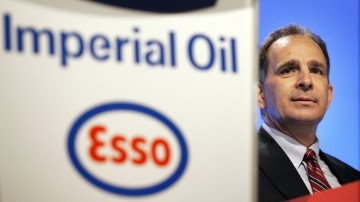

Imperial gives Kearl project green light
Nathan VanderKlippe
Globe and Mail
Tuesday, May. 26, 2009
 Battered oil sands industry welcomes decision to proceed with mine's $8-billion Phase 1 |
Imperial Oil Ltd.'s (IMO-T43.501.273.01%) approval of a major new $8-billion project is sparking optimism for a revival in the oil sands after months of project delays due to low crude prices and high costs.
By the time it starts pumping bitumen in 2012, the first phase of the Kearl oil sands mine, which was approved Monday by Imperial's board, will produce 110,000 barrels a day. It's a project that chief executive officer Bruce March has called “the biggest single investment our company has ever made in a pretty volatile market period.”
Yet even before that investment is fully made, Kearl is already providing a spark of confidence in a province that has spent the past six months watching its primary industry stage a full-scale retreat.
Among construction leaders, financial analysts and even competitors, the decision to build Kearl comes as an important symbol that despite continued low crude prices, tight financial markets and the threat of costly new greenhouse gas regulations, the oil sands remain viable.
“Are the oil sands back?” said Robin Mann, CEO of Calgary-based AJM Petroleum Consultants.
“Not yet. But I think we're just on the cusp.”
The decision by Imperial, which is 70-per-cent owned by Exxon Mobil Corp., serves as a notice that some of the industry's most successful minds continue to believe in the viability of the oil sands, which contain the Earth's second-largest oil reserves but face an increasingly difficult slate of problems.
“The death of the oil sands has been greatly exaggerated,” said Brad Bellows, spokesman at Suncor Energy Inc. (SU-T36.210.541.51%) Industry observers are looking to Suncor as the next sign that the oil sands truly are resuming growth plans.
Suncor has said it expects to revive some of its own stalled projects – it has already partly built its Voyageur upgrader and the third phase of its Firebag in situ project – but is waiting to complete its proposed merger with Petro-Canada before making any further decision.
“It's a matter of when, not if,” Mr. Bellows said.
The hefty cost of developing the oil sands makes them ripe for consolidation by the world's major energy producers but, with the exception of Total SA, the threat of costly environmental regulations – especially in the United States – has made these companies leery of pursuing further acquisitions, Calgary investment bankers say.
Watching Imperial move forward is a signal that those issues should be manageable, said Will Roach, CEO of UTS Energy Corp., which owns 20 per cent of Fort Hills, another proposed oil sands mine.
“The fundamental message is that a big company that's pretty well connected in the U.S. is committing to a project of this nature because it believes it will give them financial returns,” Mr. Roach said in an interview.
“Exxon has a huge portfolio of opportunities and this ranks highly among them. I think that's good news for the oil sands.”
The decision is a bet that crude will rebound to above $80 (U.S.) a barrel, the price analysts say Kearl will need to turn a 10-per-cent after-tax profit.
Located 70 kilometres northeast of Fort McMurray, Kearl has long been contemplated by Imperial, which produced its first $5-billion to $8-billion cost estimate for the project in 2004.
Imperial expects Kearl to eventually produce 345,000 barrels a day, but has not released cost estimates for full construction of the project, which is expected to last a half-century as the company mines out 4.6 billion barrels of recoverable bitumen.
The company initially expected to make a decision on building Kearl last year, but delayed in an effort to bring its costs down.
Construction of the first phase will employ up to 5,000 people – a shot in the arm for a province whose construction work force has fallen from 160,000 to about 120,000.
Still, Alberta Federation of Labour president Gil McGowan said Kearl is a mixed blessing. Without an upgrader on site, the project is designed to ship unprocessed bitumen out of province, a fact that could bring future harm, Mr. McGowan said.
“In the long term, it will actually be part of the problem rather than part of the solution because it will contribute to shipping more processing jobs down the pipeline from Alberta to refineries primarily in the American Gulf Coast,” he said.
Posted by Arthur Caldicott on 26 May 2009